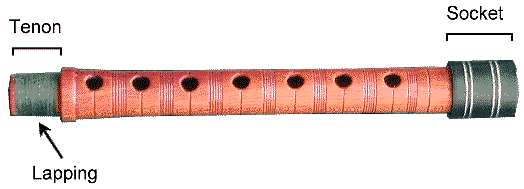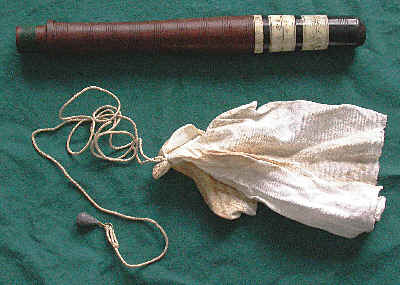
Unless you bought a plastic kaval, your kaval is probably made of wood. Wooden instruments need some care or they will deteriorate. This guide will help you keep your kaval in good shape.
There are many problems that are related to the kaval getting too dry. It needs to be kept from drying out, so there is some moisture in the wood. When a dry kaval is played, it can crack or the tenons can break. You don't need so much moisture that it is wet, but just enough to keep the wood at about the moisture level it will have when it is played.
Cracks
Kavals can develop cracks. Even a small crack is an opening that will change the
way the kaval plays, usually making it very difficult to get a clean tone.
Cracks most often are caused by playing a very dry kaval without first re-hydrating it. Moisture from your breath is absorbed into the inside of the kaval first. This moisture causes the wood to swell. But the outside is still dry, so it doesn't swell much. The force of the expanding inner layer is so strong, it causes the outer wood to split apart, and the instrument cracks open.
After the crack forms, it may be very difficult to see, and it may not cause a problem. But usually, the crack gets bigger over time. Sometimes it will open up after playing for a while, as the moisture swells the wood.
Cracks can sometimes be repaired by putting instant cyanoacrylate glue ("Crazy Glue") in the crack. If the kaval is old, this may not work very well. If you have a cracked kaval, and I will try to help you.
Shrinking Tenons
The tenon is the end of the kaval that fits inside another part called the
socket..

A Bulgarian kaval has two tenons, one on the upper mouthpiece part, and the other on the middle part with the finger holes. These tenons are usually wrapped with thread to make a snug fit in the socket of the piece below.
If the kaval is allowed to dry out for a long time, the wood shrinks. When you put the kaval together, the tenon is loose in the socket, so you wrap some more thread around the tenon to make the lapping thicker, and then the kaval fits snugly again. Now if you play this kaval, the moisture from your breath will expand the wood, including the tenon. But the tenon is firmly held within the socket, which is reinforced with horn or bone, and it won't give. So the tenon wood compresses. Now if you allow the kaval to dry out again, the tenon shrinks again, but this time it shrinks a little more than before, so the next time you try to play, the tenon is loose in the socket again. More thread is applied, and the process repeats, causing gradual permanent shrinking of the tenon. After several cycles, the wood may finally break and the tenon comes off.
Tenons can be replaced by a kaval maker. I have replaced tenons in kavals myself. If you have a broken kaval, and I will try to help you.
The best way to protect your kaval from drying out too much is to keep it in a plastic bag when you aren't playing it.
Swab Out the Moisture
Before you put your kaval away after playing, you should swab out the inside to
get most of the water out. I use a small piece of cloth tied around a string. On
the other end of the string I have a fishing weight. Drop the weighted string
down the kaval from the bottom end, and pull the cloth through. It doesn't have
to be bone dry. In fact, it is probably best to leave just a little moisture
inside.
 My kaval swab
My kaval swab
Wrap it in a Cloth in a Plastic Bag
I wrap my kaval in a cloth, to protect
the pieces from banging into each other, and then put the bundle in a thick
plastic bag. I just wrap the bag around the kaval; I don't try to seal the bag
shut. This is sufficient if you play at least once a week. If your kaval isn't
played for a long time and it dries out, you should rehydrate it before
playing it.
If you have a kaval which has been allowed to completely dry out, before you play it, you should rehydrate it. This is a gradual process of adding moisture to the wood so that it won't crack or have other problems when you play it.
Moisten a small sponge with water. Place the disassembled kaval and the sponge together in a plastic container with a tight-fitting lid. Be sure the sponge doesn't directly touch the kaval, and that any water that may drip out of the sponge will not contact the kaval. I put the kaval on a little wire rack and the sponge underneath the rack. Leave the container covered for several hours or overnight. You should notice that the kaval fits together more tightly, but it should not be damp.
Wooden kavals should be oiled periodically. I recommend you apply oil every 10 hours of playing time.
The Bulgarians use olive oil, but I recommend you use almond oil. You can find it in health food stores. Don't use the very expensive kind for massage, which may also have perfume in it. Get almond oil sold for cooking.
An easy way to oil your kaval is to make a second swab with a fishing sinker and a cloth just for oiling (see above). First, swab out any moisture with your regular swab. Then, put a liberal amount of oil on the oiling cloth and pull it slowly through the kaval from the mouthpiece down. You can oil the entire kaval, assembled, in one pass. Do this over the kitchen sink, because the oil will drip and make a mess unless you are very careful.
I use a special oiler I made with a small round sponge tied on one end instead of a cloth. I drop the weight through the kaval from the top, and then carefully squeeze the sponge into the mouthpiece and pull it down about 2 cm (1 inch). Then I pour about a spoonful of oil on top of the sponge, and very slowly pull the sponge through the kaval.
After oiling the inside, you can put a small amount of oil all over the outside. Treat the outside like furniture - you don't want to slick with oil. Too much oil on the outside and the kaval will become sticky later. After putting oil on the outside, wipe it all off with a dry cloth or paper towels. Then disassemble the kaval and wipe off the oil from just inside each of the pieces. Try to get the insides of the sockets clean of oil, because it will dissolve the wax on your lapping.
I don't recommend that you soak your kaval in oil. It will dissolve the glue in the reinforcements and the mouthpiece, and things will come apart. Also, when you play it, the moisture will cause the oil to weep out all over your hands.
The lapping is the thread gasket wrapped around the tenons. You can replace it yourself with these instructions.